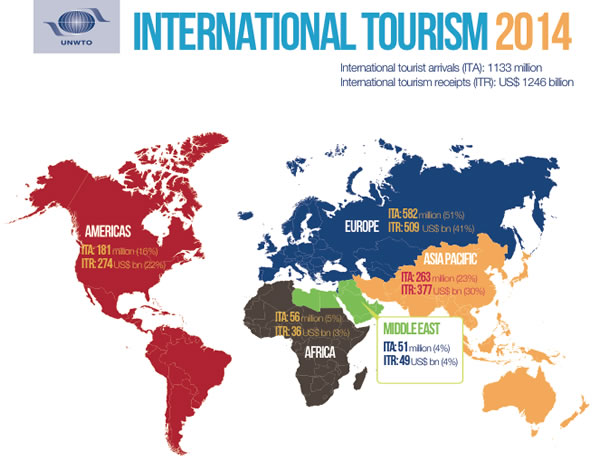 |
“It is encouraging to see the tourism sector consolidating its excellent results despite security concerns and unrest in many parts of our world“ |
Taleb Rifai Secretary General UNWTO |
INTERNATIONAL. The innate resilience of the global tourism sector that underpins the travel retail industry has been borne out once again by international tourist arrival figures for the first four months of 2015.
Despite a troubled geo-political and economic climate in many parts of the world, tourist arrivals increased by +4% year-on-year worldwide according to the latest UNWTO World Tourism Barometer.
Almost all regions enjoyed strong growth and Prospects for the May-August period remain upbeat, UNWTO said. Close to 500 million tourists are expected to travel abroad during these four months.
Destinations worldwide received some 332 million international tourists (overnight visitors) between January and April 2015, 14 million more than the same period last year, corresponding to an increase of +4%.
This result follows an increase of +4.3% in 2014 and consolidates the upwards trend of international tourism in recent years (+4.5% international tourist arrivals a year on average since 2010).
By region, the Americas (+6%) led early 2015 growth, followed by Europe, Asia and the Pacific and the Middle East, all recording +4% to +5% more arrivals. By sub-region, Oceania and South America boasted the strongest increase (both +8%), followed by the Caribbean and Central and Eastern Europe (both +7%), the latter rebounding from last year’s decline.
In Africa, demand weakened in 2014 after years of solid growth, affected mainly by the Ebola outbreak among other challenges. Limited data currently available for January-April 2015 points to a -6% decline, as African destinations struggle to recover from the misperceptions affecting the continent.
“It is encouraging to see the tourism sector consolidating its excellent results despite security concerns and unrest in many parts of our world,” said UNWTO Secretary-General, Taleb Rifai.
“This underscores that tourism is a surprisingly resilient economic sector which increasingly contributes to development in many countries around the globe. For national governments, it is a reminder that tourism can be part of the solution to foster socio-economic development and job creation”, he added.
Strong results across many destinations; rebound in Central & Eastern Europe
In the Americas (+6%) all four sub-regions continued to enjoy significant growth in January-April 2015, led by South America (+8%) and the Caribbean (+7%). Strong outbound demand from the USA fuelled results as 20 million US tourists travelled abroad through April, +7% more than during the same period last year.
Asia and the Pacific (+4%) consolidated the growth of recent years, with Oceania (+8%) and North-East Asia (+5%) in the lead. Southeast Asia (+3%) recorded moderate results during the four-month period as the rebound in Thailand (+25%) was offset by declines in other destinations.
Europe, the world’s most-visited region, enjoyed continued strength with international tourist arrivals growing by +5% through April. Arrivals in Central and Eastern Europe increased by +7%, rebounding on the poor results of 2014 following the conflict in Ukraine and the slowdown of the Russian economy.
Southern Mediterranean Europe (+5%) maintained strong growth, though for many destinations these are low season months. Western Europe and Northern Europe both enjoyed solid 4% increases in arrivals, partly due to good results in traditional winter sports destinations.
International tourist arrivals in the Middle East are estimated to be up by +4% through April, further continuing the region’s recovery which started in 2014 after three consecutive years of declines.
Africa’s international tourist numbers, on the other hand, declined by an estimated -6% as a consequence of the decrease in arrivals to North Africa (-7%) as well as to sub-Saharan Africa (-5%). Figures for both Africa and the Middle East should be read with caution, as they are based on limited available data for these regions, UNWTO said.
“The Ebola crisis in West Africa and the security concerns are serious challenges for Africa’s tourism and for the international community as a whole. We must work together in managing and overcoming these challenges and in supporting destinations for a prompt recovery. It is important to remember that tourism is the lifeline of many communities around the world and that we face today a global threat that affects all our societies,” said Rifai.
 |
This UNWTO graphic underlinees the vital role of tourism to the global economy |
Optimistic prospects for the coming months
Close to 500 million tourists are estimated to travel abroad between May and August 2015, the Northern Hemisphere holiday peak season, a total that accounts for some 41% of all international tourist arrivals registered in a year.
According to the latest results of the UNWTO Tourism Confidence Index, prospects for this period continue to be bullish and are the highest for this period since the pre-crisis year 2007. The sentiment is positive among all regions and areas of activity.
Business intelligence tool ForwardKeys also shows healthy growth in international air travel reservations for May-August 2015.
Overall bookings are up +5% thanks to strong demand for domestic air travel (+7%) and continued growth in international travel (+4%). By region, air reservations increased most in Asia and the Pacific, the Americas and Europe, while reservations to and from Africa and the Middle East are weaker.
According to the forecast issued by UNWTO in January this year, international tourist arrivals are expected to increase by +3% to +4% for the full year 2015, in line with UNWTO’s long-term forecast of 3.8% a year for the period 2010 to 2020.
Please note that results presented here reflect preliminary data reported to date and are subject to revision.




